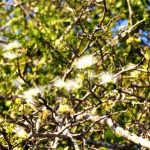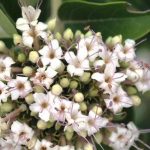TREE LIFE
April 1999
The annual subs ($80) are due. If you haven’t already paid, please complete the in voice attached to this Tree Life, and indicate if your address has changed.
MASHONALAND CALENDAR
Tuesday 6 April. Botanic Garden Walk. Weather permitting our walk in the economic section continues and we will also have a look at more of the little known and seldom seen species on Mark’s list. We will meet Tom in the car park at 4.45 for 5 p.m. – there wilt be a guard for the cars.
Sunday 18 April. Welston Road Teviotdale. By courtesy of Sue Garnett and John and Sue Holloway we revisit their property just north of Harare. Mark’s November walk was here and it was decided that a return visit to this spot would be worthwhile.
Meet at 9.30 a.m. with lunch and a raincoat.
Saturday 24 April. Mark’s walk this month will be to the Mukuvisi Woodland. Meet in the car park at 2.30. Bring your Tree Life in case it is required for entry to the woodland.
Saturday 1 May. (Back to wintertime) Botanic Garden Walk.
Sunday 16 May. A.G.M. Christon Ban
NOTICE OF ANNUAL GENERAL MEETING
Notice is hereby given that the 49th Annual General Meeting of the Tree Society of Zimbabwe will be held on Sunday 16th May, 1999 at Christon Bank Botanic Garden Extension.
AGENDA
1. Notice convening the meeting.
2. Apologies.
3. Minutes of the 48th AGM
4. Matters Arising.
5. Chairman’s Report.
6. Treasurer’s Report.
7. Election of Committee Members.
8. Any other Business.
Any proposals/resolutions and nominations for office bearers should be forwarded to P 0 Box 2128, Harare by Monday 10th May if possible, although proposals and nominations will be accepted from the floor.
Thursday 20 May. Dr Walters from Fairchild Botanical Gardens in Florida USA will be giving a talk at the Conquenar Hall (Reimbata) behind Haddon Motors along
MATABELELAND CALENDAR
Sunday 4 April. Meet at the car park in Girls’ College at 8 for departure at 8.30 a.m.
To confirm the venue please phone Jonathan Timberlake, Tessa Ball or Gill Short.
On a date still to be fixed Tom Raub has agreed to show some of his slides of plants which grow in his home state of Virginia USA.
FLOODS AN ‘ACT OF GOD’?
It has been a terrible year for floods, but if we are to believe the weathermen, we have not seen anything yet! As global warming takes hold, forests are felled, and rivers tamed, they say waters will rise faster, further, and more frequently.
‘Acts of God’ are actually aided by man. It takes more than rainfall to make a flood. With Hurricane Mitch [in Central America] the rain caused a disaster because it fell on mountains that had been cleared of forests and built on. Trees are safety valves, trapping rain and breaking its fall to the ground, and allowing it to percolate slowly into the earth. Each tree of a mountain forest can hold up to 1 820 litres of water in its root zone, but when trees are cleared the water runs straight off bare hills, causing floods. Eroded soil is carried down the rivers, raising their beds, and making it more likely that they will burst their banks. It is much the same story in many of the sites of [the recent] floods. Forests have been felled in over 80% of the Yangtze Basin. Floods in Bangladesh have increased enormously because of deforestation in the Himalayas, where at least 40% of the trees have been felled in the past 40 years. Deforestation and illegal building also brought about the mudslides in Italy. The inquiry into Britain’s Easter Floods was told that half the houses built since the Second World War have been imprudently sited on areas prone to flooding.
Efforts to prevent inundation by ‘taming’ rivers, straight¬en¬ing them out and building embankments, make things worse. In 1926 the US Army Corps claimed that such work made the Mississippi safe from flood damage, but in the very next year floods rendered 700 000 people homeless. Another flood in 1993 broke two-thirds of the river’s artificial banks. In Europe 90% of the upper Rhine is cut off from its floodplains, and now flows twice as fast as before. It flooded disastrously in 1993 and 1995, but there are now attempts to restore some of the original wetlands. Every 1% increase in these natural sponges is thought to reduce flooding by up to 4%. The removal of vegetation, the increase in the amount of hard surfaces such as tarred roads and tin roofs, and the destruction of wetlands have created more run-offs, and increased the size of floods. So – ‘acts of God’?
Taken from Forestry for a Small Planet, Autumn 1999, with minor amendments to the text.
-Lyn Mullin
MATABELELAND BRANCH – 7 MARCH
Chelmsford Park Bulawayo
Grey skies and ‘guti’ awaited a pleasant surprise of a dozen eager enthusiasts who met at Chelmsford Park to identity the following trees for eventual labelling:
Acacia gerrardii; Acacia nilotica; Acacia robusta (subsp. robusta); Albizia amara; Bolusanthus speciosus; Combretum hereroense; Cassine transvaalensis (Crocoxylon); Dovyalis caffra; Ehretia rigida; Euclea divinorum; Lonchocarpus capassa; Maytenus senegalensis; Ozoroa insignis (Ozoroa reticulata);
Many of the trees were old and knarled, and because of this it was suggested that younger trees be planted close by to rejuvenate the park. This will be done sometime.
Chelmsford Park is a Municipal property and sublet to the Girl Guides. Years ago exotic trees were planted for shade and these we hope to label on another visit.
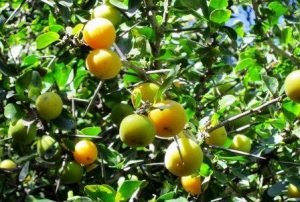
Dovyalis caffra. Rob Burrett. Source: Flora of Zimbabwe
The Dovyalis caffra was in good condition so heavily laden that the fallen fruit lay like a golden carpet under the tree – a feast for the eyes, insects, birds and beasties.
It was so nice to have Jonathan’s young son and daughter join us. Their interest in the trees, birds and bird nests was lovely to see. The perfect age to start learning.
Due to the damp weather we dashed from tree to tree and soon identified the necessary trees; without the usual deliberation and gentle meandering that makes tree walks so delightful. This meant an early close to the morning but not without thanks to the members for their knowledge and help, and to Bev for kindly jotting down the names for this article.
P.S. Does anybody have a recipe for Kei-apple jelly? If so please forward to Tree Life.
Angela Murray.
CALGARY FARM 21 FEBRUARY 1999.
Despite the excessively wet conditions a surprisingly good turnout of members followed Mark along the road as most other areas were rapidly becoming small dams, being fed by the gushing streams. With all the herbaceous material at its prime and with Mark in the lead we had a far more varied approach to our outing, including some amateur meteorology – eyeing the cumulus clouds piling up overhead and preparing for a quick exit, however, with luck the sun eventually appeared.
The Mazowe river valley is an attractive area and during the wet months provides lush conditions so it’s not surprising that exotics have invaded and one of the most successful of these is the spiny Duranta repens, the forget me not tree which produces small rounded orange fruits that are attractive to birds resulting in its widespread distribution. This season has also been very good for the ubiquitous Cherry Pie – Lantana camara which has literally gone crazy countrywide. This species of Lantana is also supposed to be toxic to livestock. Other exotics that have escaped in this riverine zone are few Eucalypts but Jacaranda mimosifolia and Toona ciliata (was Cedrella toona) are a significant menace to naturally occurring woodlands. As the riverine woodland is a canopy of mainly Celtis africana, a number of climbers occur including Podranea brycei – the well-known Zimbabwe creeper, so called as it is very common around the ruins of that name and also in the hills in the south east of the country. Very attractive pink flowers are produced in sprays has compound leaves and common to the Bignoniaceae family produces a pod that splits or dehisces releasing flat winged seeds. Other climbers included one of the Solanum family, Solanum seaforthianum where swathes of small purple flowers descend from the tangle of stems. A curious feature of Mondia whitei once the large leaves with the attenuate tip are parted is the stipule structure, stiff and almost bract like with a fringe of teeth. Better known is the Adenia gummifera – this has a distinct green stem with white streaks and small glands are found at the base of each leaf and exude a substance that is reputedly popular with ants and one of the traditional uses of the roots is to treat madness.
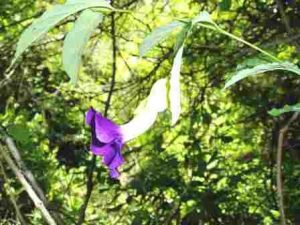
Thunbergia crispa. Photo: Mark Hyde. Source: Flora of Zimbabwe
Possibly the most attractive find of the day –Thunbergia crispa, a purple five lobed flower just visible in the tangle of stems with a yellow throat and long pale corolla. A bract is at the base of the flower looking like a short opened pea pod. At the really primitive end of the plant kingdom are the mosses and liverworts and here Cheryl noted the latter festooned around the boles of trees following small water¬courses. These flat lobed almost moss like plants occupy the lower end of the succession story and are in fact more primitive than mosses and require a wet environment in order to survive and reproduce.
For those suffering from herbaceous overload the trees become more varied once the woodland opens away from the riverine zone with Terminalia, Combretum and a puzzle – Zanha africana with a confusing compound leaf – Imparipinnate or not? This seems to depend on which leaf you look at! For the trees of note along the stream, a magnificent Ilex mitis knarled and of immense size for this part of the country and very tall Catha edulis – the Bushman’s tea. A small Dovyalis zeyheri caught our attention with something being mentioned about a carrion smell – c’mon you budding botanists has anyone smelt this feature?
A final sweep and back to the cars and a few annuals pointed out included Cyphia mazoensis, a member of the Lobeliaceae family, that twines around and up grasses producing a most attractive purple flower and the other annual that caused much nasal activity with its strong citrus smell is Satureja biflora, the two small rounded leaves at opposite positions on a slender and angular stem. John Wilson noted the presence of Shamva grass and provided this interesting piece of information about it:
Rottboellia exeltata, 1-3m tall is kept upright by prominent stilt roots. The basal leaf sheaths have stiff sharp hairs making it painful to grasp the lower stem and the inflorescence breaks into hard cylindrical seeds.
A bad weed, highly competitive with crops being so tall and tending to be a late emerger and so misses the early hand cultivation’s. Resistant to many herbicides it is controlled by combination of cultivation, slashing and herbicides.
Best to rotate maize crops with cotton and Soya’s to be able to use wider range of herbicides. A weed of heavy soils, the seeds survive underground for 4 seasons. It is important to eradicate the plant every year for at least 4 years. Being late in development it tends to emerge from the top of the maize canopy late and so escapes weeding attention, so at that stage it is best to hand pull the weed and preferably remove it from the field, but control of labour at that late stage is very difficult.
Distributed throughout the tropics including China and Australia, SE USA to Brazil.
Why is it called Shamva grass? That area was one of the first maize growing areas having heavy red soils and a reasonable rainfall and I expect that the weed made its appearance pretty early on in that district. Not a compliment to the district!
Many thanks to the Wheeler family for an outing in a very interesting area and many thanks to Mark for leading a fascinating walk.
-Andy MacNaughtan
GYROCARPUS AMERICANUS
(Hernandiaceae): propeller tree
This note is in response to Andy MacNaughtan’s query in TREE LIFE No 229, much of it taken directly from Flora Zambesiaca, Volume Nine, Part Two (1997), edited by GV Pope.
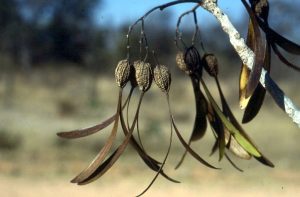
Gyrocarpus americanus, propeller pods. Photo: Meg Coates Palgrave. Source: Flora of Zimbabwe
Firstly, according to DJ Mabberley (1993), The Plant Book, there are three species of Gyrocarpus, all from tropical and warm areas, but only Gyrocarpus americanus is mentioned by name. It would seem that alkaloids are present in all species, but there is no indication of any work being done with them.
The following is from Flora Zambesiaca, which confirms the existence of three species –
Also in Eritrea, Tanzania, Angola, Namibia, and South Africa. Occasional, at low to medium altitudes, usually in hot dry areas, on rocky ridges or stony slopes of escarpments and river valleys, in riverine thickets and deciduous woodlands; 50-1175m.
Kubitzki [1969] recognizes eight subspecies of Gyrocarpus americanus of which only subsp. africanus occurs in the Flora Zambesiaca area. Subsp. americanus is widespread in both the Old and the New World tropics but in Africa is restricted to Kenya and Tanzania. It can be distinguished from subsp. africanus by its unlobed adult leaves with their glabrous to fuscous pubescent lower surfaces. Subsp. pinnatilobus from West Africa has leaves with divided lobes. The other subspecies all occur outside mainland Africa. Subsp. capuronianus, subsp. glaber, and subsp. tomentosus are apparently endemic to Madagascar and as a group are distinguished by having stamens with glabrous, as opposed to pilose, filaments. Subsp. pachyphyllus is restricted to the Australian mainland, and subsp. sphenopterus to N Australia and possibly the Philippines and Lesser Sunda Islands. Kubitzki points out that subsp. africanus show a distinct clinal variation, with fruit size, leaf-lobing, and density of indumentum gradually decreasing towards the southern and south-eastern part of its distribution. Specimens of subsp. africanus with unlobed leaves can be distinguished from the other subspecies with unlobed leaves by the greenish-white to whitish-grey tomentum on the lower leaf surface. (End of quote.)
I also had a look in Dale and Greenway (1961), Kenya Trees and Shrubs, and found two species listed, Gyrocarpus hababensis with leaf blades to 1.5 inches long (3.8 cm), orbicular-cordate, and Gyrocarpus jacquinii with leaf blades to 7 inches long (17.8 cm), cordate to 3-lobed. Whether these species are still valid or not, I don’t know. Dale and Greenway did not mention the existence of Gyrocarpus americanus subsp. americanus and it is possibly safe to assume that one of the species they listed is subsp. americanus.
It seems to me that Gyrocarpus americanus, in all its subspecies, is a Gondwanaland relic that has not yet diverged into separate species, and that could be an interesting story. It suggests that Gyrocarpus americanus was, from the outset of the break-up of Gondwanaland, already an immensely stable species. How else would one explain its failure to evolve beyond the subspecies level in 135 million years? In 1986 I examined a more-or-less pure stand of Gyrocarpus americanus subsp. africanus very close to the Sabi-Lundi confluence, and I was in North Queensland a little more than a month later, at a place called Chillagoe, where I saw one or two specimens of Gyrocarpus americanus, presumably subsp. sphenopterus, although the Australian botanists with our party did not distinguish them as such. They were instantly recognizable as Gyrocarpus, and to me, looked no different from our own subsp. africanus.
There is a very big specimen of subsp. africanus at Ewanrigg Botanical Garden, probably planted, and doing well in spite of being outside its normal altitudinal and temperature range.
A few of the terms in the quote from Flora Zambesiaca may not be familiar to readers of TREE LIFE –
Clinal – continuous gradation of form in a species, correlated with its geographical or ecological distribution.
Fuscous – of a brownish-grey colour.
Indumentum – any covering of a leaf blade.
Pilose – covered with fine, soft, simple hairs. Tomentum – dense covering of short, soft, and matted hairs.
-Lyn Mullin
VIOLINS: MASTERS OF THE MUSIC WORLD
[This article is reproduced from WOOD Southern Africa & TIMBER TIMES (WSA&TT) Vol. 23 No 11, September 1998, with minor amendments to the text, and the additions of species names for some of the woods used in violin making]The violin is probably the best known and most widely used of all orchestral instruments. According to The World Book Encyclopaedia (1982, Vol. 20) some of the greatest music in the world owes much of its beauty to the violin. WSA&TT decided to investigate the traditional art of violin making to discover why this instrument has captivated the music world for more than a thousand years.
Musicians have used many kinds of stringed instruments, such as harps and lyres, but according to the World Book Encyclopaedia the first references to stringed instruments played with a bow appear in Persian and Chinese writings from 800 AD.
Simple as a violin seems, it consists of 84 different pieces. WSA&TT contacted Brian Lisus, owner of Brian Lisus violins, who has been making traditional violins for more than 20 years, and from his workshop in Worcester, in the Cape, Lisus explained his passion for making violins. “The making of violins is a very fine type of woodworking. Working to an accuracy of a tenth of a millimetre, it is a very precise art that involves carving, gluing, and varnishing, among numerous other skills”, he said.
History
One of the first recorded bowed instruments was the Kemantche, an ancient Persian instrument consisting of a long stick extended through half a coconut. The European Rebec, popular in medieval times, resembled a long slender pear, and probably originated in the Orient. The Vielle ranked as the most important stringed instrument in the 1100s and 1200s, and had five strings.
In the 1400s players started using bows to play instruments of the guitar family, and these bowed guitars developed into instruments called viols. The violin, however, was developed from the early bowed instruments rather than from the viols. Compared in shape and construction with a viol, a violin has a longer, narrower neck, higher shoulders to the body, and a rounded back. Most important of all, the violin’s four strings are tighter strung, and are supported by a stronger, more rounded bridge. For many years viols and violins developed side by side, each influencing the other, but by the late 1600s most musicians favoured the violin family, and the viols dropped out of use.
The Viola d’Amore was held and played like the violin of today, and was used in Europe in the 1500s and 1600s. Developments over the next century led to the superb violins made in the small Italian town of Cremona. The Amati family made instruments there in the late 1500s and early 1600s, but it was Antonio Stradivari (? 1644-1737), a pupil of the Amatis, who perfected the design of the violin, and produced some of the finest instruments ever made.
Ward Lock’s Encyclopaedia of Music (1979, Alan Blackwood) explains that playing styles for the instrument have also changed. In earlier days it was often pressed against the chest rather than tucked under the chin, which did not give the player such quick control over the instrument.
Materials
The woods traditionally employed for the construction of violins are maple (Acer) or sycamore (Platanus) for the ribs, back, and neck, and spruce (Picea) for the belly. The species of maple most used are Acer pseudoplatanus and Acer platanoides. The spruce used for the front is usually Picea abies, the common Christmas tree, and Lisus imports all of this wood from European countries, such as Germany and northern Italy. The bow is made of Pernambuco wood (also known as Para wood), a lightly springy wood from the Brazilian tree, Caesalpinia echinata.
Violin makers believe that only wood that has grown at high altitudes and has had to suffer harsh conditions, such as cold weather and poor soil, is suitable for making stringed instruments. It is also thought that wood that has grown too quickly, e.g. in lush environments and rich soil, generally tends to be less resonant and less able to withstand the stresses it will be subjected to in the finished state. It is also thought that air-dried wood, seasoned for some years without being kiln-dried, is a far better choice, since fresh wood will invariably distort, check, and split. Lisus said, “It is true that ideally the wood should have been under snow all year round; this ensures that it grows very slowly and the grain is close together. It is also important for the wood to show a clear distinction between the winter and summer growth”.
The violin has four strings, which are tuned in fifths. The first string is usually made of steel, the second and third of covered synthetic materials such as perlon, while the fourth string is generally made of gut covered with aluminium, gold, silver, titanium, or tungsten.
Construction
The shape of the instrument is designed to withstand forces and direct them to a state of equilibrium, and the beauty of the curves is a direct and essential consequence of this. The main components that assist and influence the transmission of vibrations are: the ribs, bridge, sound post, and bass bar.
The ribs are four or six strips of maple or sycamore that make up the structure separating the back and front of the violin. To shape the outline of the thin strips of ribs, a mould is made, and, with heat and humidity, the ribs are bent to conform to it. The ribs are then glued to the six blocks that remain as structural reinforcement on the interior of the instrument. Since the surface of the ribs facing the plates is not large enough to form a good joint, 12 linings made of spruce, or willow (Salix), are fitted and glued to the inside of the rib facing the plate.
The purfling, or inlay, has a twofold function. Most importantly it protects the thin, fragile edges from continual wear through years of constant use, and it prevents the further continuation of cracks that often begin at the vulnerable end grain of the plates. Lisus said that he makes his purfling from stinkwood (Ocotea bullata) to, give his instruments an “African touch”.
The sound post is a thin rod of spruce, or pine (Pinus), approximately six millimetres in diameter, fitted to the interior of the instrument between the back and front. The sound post is not glued in place, but is held in position by the innate tension in the instrument caused by the pull of the strings. It also reinforces the belly, and counteracts the forces of the strings acting on it.
The bass bar is a length of spruce cut with the grain running in the same direction as the belly, and glued to the interior surface of the finished plate. Lying length wise under the right foot of the bridge, it allows the right foot to displace a larger area of the front when amplifying the lower notes.
Design
Making a violin requires great patience, especially when it comes to the graduation of the thicknesses, as each individual piece of wood has its own properties. It takes a long time to shape and thin the wood, tapping and flexing until the violin maker is satisfied with the response of each piece. When it comes to the hollowing of the plates the violin maker is confronted with one of the more difficult aspects in the making of the instrument. Lisus said that the thickness of the wood has a major influence in determining the sound of the instrument. The front and back plates must be worked fairly thin to be able to resonate easily, but because they must also support a lot of tension they are shaped into a very exact arch. The exterior contour, or arch, of the back and front of a violin are carved using gouge planes and scrapers. “Arching has a very important influence on sound. To obtain a darker, deeper sound, the arching needs to be scooped more. It is definitely the most difficult aspect of making a violin, as most of it is done by eye, and can’t be accurately measured”, said Lisus.
Joints/gluing
The glue used for all joints of stringed instruments is, traditionally hide glue made from converted collagen. It is very strong glue, able to hold wooden parts together with great force. As hide glue is not an adhesive that fills gaps, the plane iron has to be honed to a razor-sharp edge, and the joints planed with great precision.
The main benefit of hide glue in the construction of musical instruments is its reversibility. When instruments need to be repaired or restored the hide glue will always come apart without damaging the wood.
The joints in a violin include simple butt joints, such as the centre joints or the plates, and the complex joints of the neck.
Ornamental
The sound holes with their curious shape, although apparently ornamental, have a great influence on the tone of the instrument. The size, or openness, of the holes influences the frequency of the vibrating mass of air within the instrument. They are cut with a small, fine saw, and then finished with a razor-sharp, pointed knife.
The scroll is the only part of the violin that serves no real purpose, but it is an important aesthetic addition that allows the violin maker to express his style and passion.
The varnish secret
For years music connoisseurs have been debating what made the old Cremona violins so superior. Apart from the fineness of the workmanship in every part, and the careful choice of wood, the secret is believed to lie in the composition of the varnish.
The varnish permeates the wood to protect it from dirt and sweat, and covers the instrument with a coloured sheath for purely aesthetic purposes, while remaining thin and light enough not to constrict the instrument. The varnish used is believed to be so crucial to the instrument that Lisus took more than six months off his work to further his research into the varnish that was used in the 17th century. Lisus explained that the slow-drying varnish that was used at that time was replaced by a quicker-drying, spirit-based varnish, and the recipe for the old varnish was lost. “I realized”, he explained, “that obtaining the same quality varnish used by the masters would only be possible by using the materials that were available in that century. After all my research I now use an authentically made varnish consisting of cold-pressed linseed oil, colophony (simple pine resin), a little bit of amber¹, or sandarac ², applied to a silica ground coat. I believe that the secret lies in using natural, authentic materials”.
The average price for a traditional, hand carved violin, which takes between six and eight weeks to complete, is around US$6500. However, the record price for a musical instrument was paid in 1990, when a Stradivari violin, of which only 635 are known to exist, was bought for US$1.7 million.
Whether it’s in the wood that has to withstand harsh conditions, the precise woodworking, the fine details, or the secret varnish, violins made by Stradivari have never been surpassed in tone, power, and form.
¹ a yellowish-brown, translucent, fossil resin from extinct conifers, now found in Tertiary deposits.
² a pale-yellow, transparent resin obtained from the conifer Tetraclinis articulata.
-Lyn Mullin
ANDY MACNAUGHTAN CHAIRMAN
that the slow-drying varnish that was used at that time was replaced by a quicker-drying, spirit-based varn
ish, and the recipe for the old varnish was lost. “I realized”, he explained, “that obtaining the same quality varnish used by the masters would only be possible by using the materials that were available in that century. After all my research I now use an authentically made varnish consisting of cold-pressed linseed oil, colophony (simple pine resin), a little bit of amber¹, or sandarac ², applied to a silica ground coat. I believe that the secret lies in using natural, authentic materials”.
The average price for a traditional, hand carved violin, which takes between six and eight weeks to complete, is around US$6500. However, the record price for a musical instrument was paid in 1990, when a Stradivari violin, of which only 635 are known to exist, was bought for US$1.7 million.
Whether it’s in the wood that has to withstand harsh conditions, the precise woodworking, the fine details, or the secret varnish, violins made by Stradivari have never been surpassed in tone, power, and form.
¹ a yellowish-brown, translucent, fossil resin from extinct conifers, now found in Tertiary deposits.
² a pale-yellow, transparent resin obtained from the conifer Tetraclinis articulata.
-Lyn Mullin


